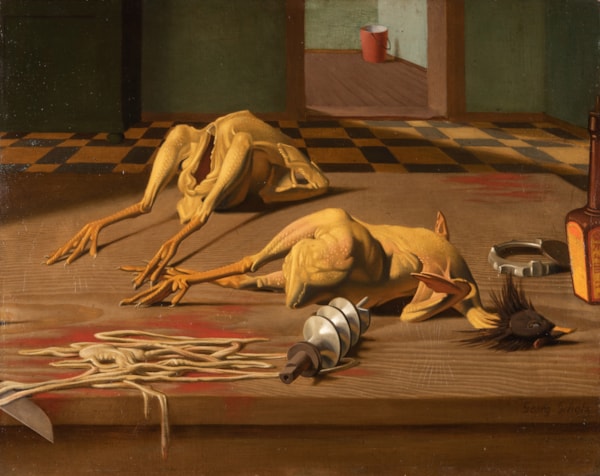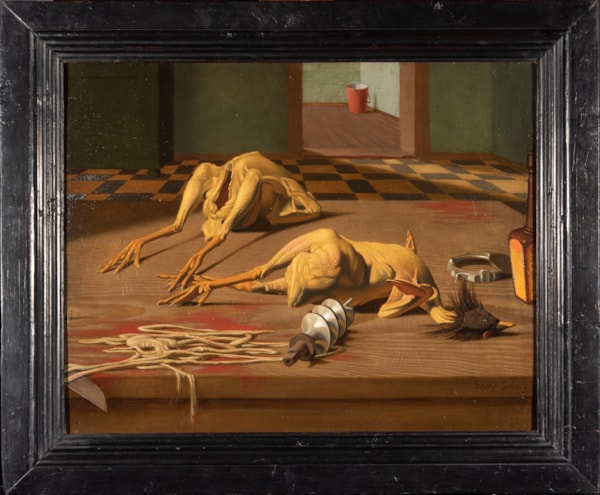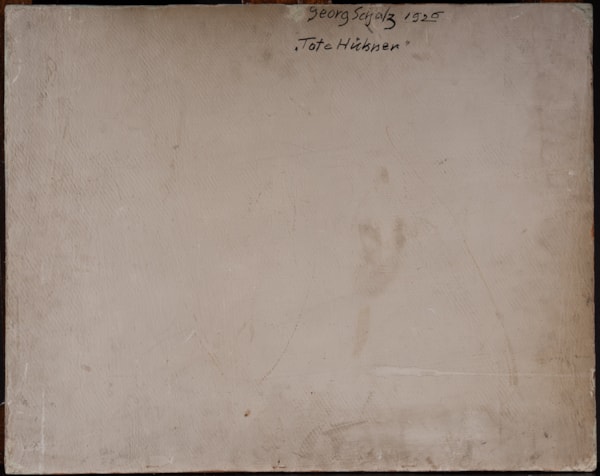Georg Scholz (1890 - 1945)
Provenance:
Artist's studio; Family-owned in Karlsruhe; Sale, Berlin, Dr. Irene Lehr Kunstauktionen, October 29, 2022, lot 333
Exhibition:
International Art Exhibition Dresden 1926, catalog no. 616;
Post-war painting. Essen, Museum Folkwang, 1926, catalog no. 69;
George Scholz. Karlsruhe, Badischer Kunstverein eV, 1975, catalog no. 63
Literature:
Felicia Sternfeld, Georg Scholz (1890 - 1945) catalogue raisonné, 2004, p. 164, cat. no 48
On a blood-soaked tabletop, two chickens lie between parts of a meat grinder and a bottle of seasoning. Warmly lit and pliant like newborns, their textured flesh contrasts with the sheen of the metal and the feel of the feathers. Spilling over the table edge, eviscerated guts lie in front of delicate orange feet. A doorway leads to another room, empty except for a bucket soon to be used to clean up the mess.
A leading Neue Sachlichkeit (New Objectivity) artist, Georg Scholz wrote to his friend and patron Dr. Theodor Kiefer on January 31, 1926, in advance of the Internationale Kunstausstelung soon to open in Dresden:
“Then I promised a major work by my hand to the Dresden Picture Gallery for the International (deadline April 15). This is the chicken still life I’m working flat out on. This will be ready in 8 days. But I have to work like a savage for these 8 days.”
In prints and paintings, Scholz used satire and exaggeration to skewer capitalism, showing resigned newspaper carriers, bloated war veterans and industrialists with pig-like faces. The influence of Dada appears in figures with screws through their heads and depraved youths biting frogs. Scholz also painted landscapes in a clear light that reflect the influence of Giorgio de Chirico. Cacti still lifes and self-portraits also appear in his rare painted oeuvre.
Many New Objective artists were born in the 1890’s and served in WW1. Succeeding the Expressionists (Die Brücke and Der Blaue Reiter), these artists focused on the details of city life during the Weimar Republic, whether in the street, railroad station, night club or brothel. Their sense of beauty recorded the scars on a face, the pattern of a tattoo or the shenanigans in the bedroom. A fascination with Old Master painting techniques is evident in smooth surfaces and sharply focused details. Their ordered compositions and graphic precision herald a return to classicism that had parallels throughout Europe.
Scholz’s Dead Chickens recalls the haunting still lifes of the 18th century Spaniards Luis Melendez and Francisco Goya. The pronounced graining of the pine tabletop resembles trompe l’oeil elements in Cubist still lifes. Chaim Soutine, Grant Wood and William Harnett also painted memorable images of chickens. Inevitably, Scholz’s Dead Chickens has anthropomorphic associations with industrial killing and the carnage of war.
In 1933, Scholz took a sabbatical from his teaching post at the Karlsruhe Academy. By 1937, his paintings were labeled degenerate and confiscated from public collections. Surviving on portrait commissions, Scholz retreated from public life, dying soon after the end of WWII.
In excellent condition, Dead Chickens or Tote Hühner has been in the artist’s family until recently. It is a cruel, unexpected image whose perverse beauty transcends its age.









